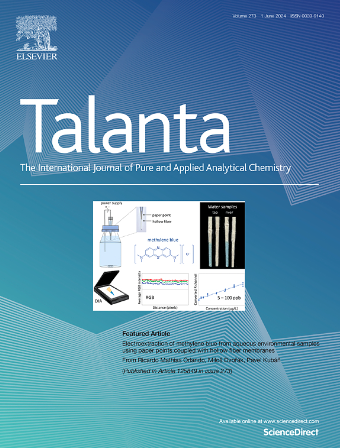镰刀菌响应材料:下一代传感、驱动和可持续作物保护策略
IF 6.1
1区 化学
Q1 CHEMISTRY, ANALYTICAL
引用次数: 0
摘要
镰刀菌属是全球农业中最具破坏性的病原体之一,对粮食安全、植物健康和可持续性构成严重威胁。传统的检测和控制方法往往存在特异性低、反应迟缓和生态问题。从这个角度来看,我们探索纳米技术,化学传感和智能驱动的融合,以定义一个新的范式:镰刀菌响应材料能够实时识别病原体和自主干预。我们研究了镰刀菌特异性生化特征,挥发性有机化合物(VOCs),真菌毒素(例如伏马菌素B1)和酶标记物,作为生物传感的可操作线索。在此基础上,我们讨论了先进的传感器平台,包括电化学、光学和等离子体系统功能化的生物受体,如适体、抗体和分子印迹聚合物。刺激反应性纳米载体的整合可以通过感染相关的触发因素(如pH值、酶、氧化还原变化或光)激活,实现按需抗真菌递送。最近的发展也突出了生物传感设备和机器学习算法之间的协同作用,增强了检测特异性和现场鲁棒性。展望未来,我们提出了传感-驱动融合的整体愿景,其中智能材料既可以检测真菌威胁,又可以智能地响应真菌威胁。由摩擦电和光伏机制驱动的自供电生物传感器的出现,为现场应用增加了新的自主性和可持续性。关键方向包括人工智能驱动的传感器阵列、叶子上的实验室平台和用于局部治疗的多功能生物杂交系统。通过整合化学传感、材料科学、植物病理学和合成生物学的见解,该展望展望了下一代作物保护框架,该框架具有响应性、精确性和环保性。本文章由计算机程序翻译,如有差异,请以英文原文为准。

Fusarium-responsive materials: A next-generation strategy for sensing, actuation, and sustainable crop protection
Fusarium spp. are among the most destructive pathogens in global agriculture, posing serious threats to food security, plant health, and sustainability. Traditional detection and control methods often suffer from low specificity, delayed response, and ecological concerns. In this Perspective, we explore the convergence of nanotechnology, chemical sensing, and smart actuation to define a new paradigm: Fusarium-responsive materials capable of real-time pathogen recognition and autonomous intervention. We examine Fusarium-specific biochemical signatures, volatile organic compounds (VOCs), mycotoxins (e.g., fumonisin B1), and enzymatic markers, as actionable cues for biosensing. Building on this, we discuss advanced sensor platforms, including electrochemical, optical, and plasmonic systems functionalized with bioreceptors such as aptamers, antibodies, and molecularly imprinted polymers. The integration of stimuli-responsive nanocarriers enables on-demand antifungal delivery, activated by infection-related triggers such as pH, enzymes, redox changes, or light. Recent developments also highlight the synergy between biosensing devices and machine learning algorithms, enhancing detection specificity and field robustness. Looking forward, we propose a holistic vision of sensing–actuation fusion, where smart materials both detect and intelligently respond to fungal threats. The emergence of self-powered biosensors, driven by triboelectric and photovoltaic mechanisms, adds new autonomy and sustainability to field applications. Key directions include AI-driven sensor arrays, lab-on-leaf platforms, and multifunctional biohybrid systems for localized treatment. By integrating insights from chemical sensing, materials science, plant pathology, and synthetic biology, this Perspective envisions a next-generation framework for crop protection that is responsive, precise, and environmentally aligned.
求助全文
通过发布文献求助,成功后即可免费获取论文全文。
去求助
来源期刊

Talanta
化学-分析化学
CiteScore
12.30
自引率
4.90%
发文量
861
审稿时长
29 days
期刊介绍:
Talanta provides a forum for the publication of original research papers, short communications, and critical reviews in all branches of pure and applied analytical chemistry. Papers are evaluated based on established guidelines, including the fundamental nature of the study, scientific novelty, substantial improvement or advantage over existing technology or methods, and demonstrated analytical applicability. Original research papers on fundamental studies, and on novel sensor and instrumentation developments, are encouraged. Novel or improved applications in areas such as clinical and biological chemistry, environmental analysis, geochemistry, materials science and engineering, and analytical platforms for omics development are welcome.
Analytical performance of methods should be determined, including interference and matrix effects, and methods should be validated by comparison with a standard method, or analysis of a certified reference material. Simple spiking recoveries may not be sufficient. The developed method should especially comprise information on selectivity, sensitivity, detection limits, accuracy, and reliability. However, applying official validation or robustness studies to a routine method or technique does not necessarily constitute novelty. Proper statistical treatment of the data should be provided. Relevant literature should be cited, including related publications by the authors, and authors should discuss how their proposed methodology compares with previously reported methods.
 求助内容:
求助内容: 应助结果提醒方式:
应助结果提醒方式:


